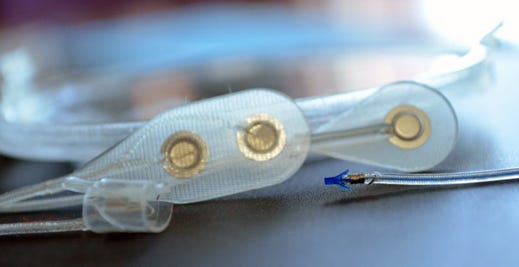Can Brain-Interface Technology Rehabilitate Paralysis?
October 20, 2015
Brain-computer interface technology as a way to bypass spinal injuries -- permitting paralyzed patients to move their limbs through the use of an implant in the brain.
Kristopher Sturgis
|
Electrodes used to stimulate muscles and create movement. |
Doctors from Case Western Reserve University in Ohio have discovered a way to circumvent a paralyzed man's spinal injury through the use of an implant that can collect signals in the brain, and convey them to electrodes embedded in the arm. The technology has restored movement to a once-paralyzed limb through the use of their wireless brain-computer interface (BCI) system.
The project aims to represents a considerable advance over previous BCI. While crude versions of the technology have been explored in the past, restoring complete mobility to a fully paralyzed limb was essentially unexplored territory.
The key to unlocking such a discovery would require tapping into specific areas of the brain that control movement -- something these researchers believe they've achieved. The process involves implanting a series of silicon electrodes, known as Utah arrays, into the patient's motor cortex. This is the area of the brain that plans movements within the body, and an area that provides valuable information about what movements a person is thinking about.
Initial experiments began with implants in the motor cortex working to control robotic arms, a process that proved the technology could not only move the robotic arms, but also stack grasp and objects. Of course the movements are still very rigid and basic, but the group believes that the building blocks are there to develop a practical system that can restore functionality and movement to paralyzed limbs unlike ever before.
BCI technologies are advancing at increasing rates, with new projects churning out promising results almost annually. Earlier this year researchers out of Brown University developed a new wireless transmitter that provided paralyzed patients with the ability to control various electronic devices. The project involves a similar technology that uses a wireless transmitter that communicates with a brain implant to help users carry out various commands using their thoughts.
Both projects indicate a shift in what could be seen as the next generation of BCI technology, as it looks to provide users with more control over their limbs and the objects around them, without the need of any external help.
Of course for patients suffering from paralysis, these potential BCI solutions can't come quickly enough. So far, volunteers for the project for the brain-implant study at Case Western Reserve University have reported that the movements provided by the technology remain uncoordinated and unnatural, but with time the team believes more control and movement can be restored.
"If I could take the system I am using right now home with me, I would do it in a heartbeat," said one participant in the study. "There are limitations to it, but they're easily outweighed by the benefit of being able to grasp something and move it around."
The potentials of BCI technology certainly can't be ignored, but much of the hype must be taken with a pinch of salt as well. While it may not be the immediate solution to paralysis, the technology appears to be inching its way toward a viable treatment option for many patients.
Learn more about cutting-edge medical devices at Minnesota Medtech Week, November 4-5 in Minneapolis. |
Like what you're reading? Subscribe to our daily e-newsletter.
About the Author(s)
You May Also Like



